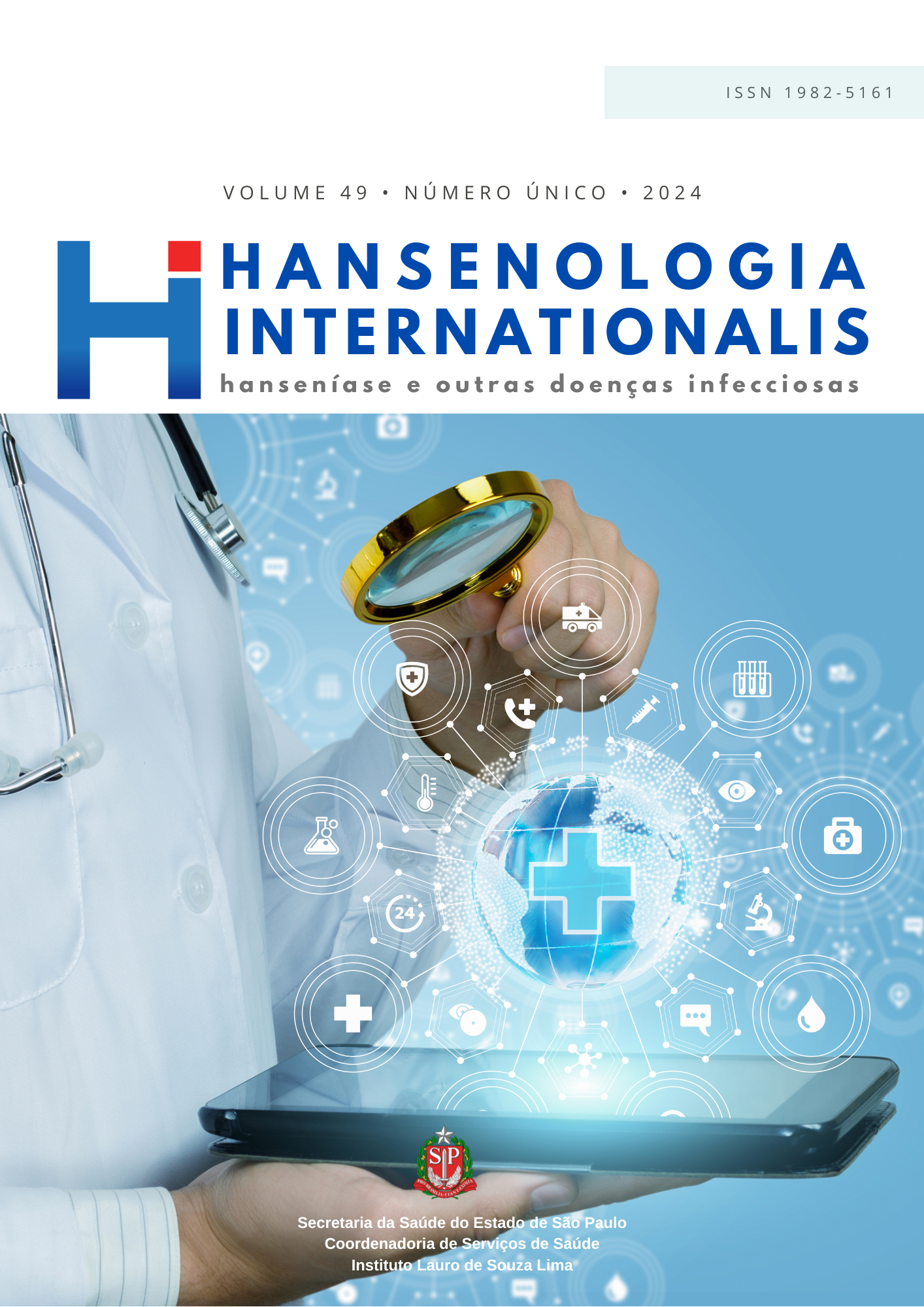Abstract
Introduction: leprosy is a chronic infectious disease caused by Mycobacterium leprae (M. leprae), an obligate intracellular parasite. Thus, host resistance to this pathogen depends on cellular immunity. The use of experimental models has made it possible to study leprosy from an immunological, microbiological, and therapeutic point of view. However, the differences in the progression of the infection between the most used models (immunocompetent mice, BALB/c, and congenitally athymic mice, nude) have been little studied. Objective: to compare the evolution of M. leprae infection in BALB/c and nude mice in terms of bacillary multiplication and evaluation of the systemic inflammatory profile by quantifying serum cytokines and nitric oxide (NO). Methods: the mice were inoculated with M. leprae in the footpads and evaluated at 3, 5, and 8 months after infection. Results: nude mice showed progressive bacillary multiplication in the footpads. In BALB/c mice, the number of bacilli was higher at 5 months. In terms of cytokine quantification, BALB/c mice showed an increase in IL-2 and IL-17A and a decrease in IL-6 and NO at 8 months of inoculation. In the nude mice, there was an increase in TNF at 8 months of inoculation and maintenance of NO levels. Conclusion: the results suggest that BALB/c mice activate an immune response capable of controlling the multiplication of M. leprae, where as in nude mice the infection is progressive despite high levels of TNF.
References
1 Scollard DM, Adams LB, Gillis TP, Krahenbuhl JL, Truman RW, Williams DL. The continuing challenges of leprosy. Clin Microbiol Rev. 2006;19(2):338‐81. doi: https://doi.org/10.1128/CMR.19.2.338-381.2006.
2 Lahiri R, Randhawa B, Krahembuhl J. Application of a viability-staining method for Mycobacterium leprae derived from the athymic (nu/nu) mouse footpad. J Med Microbiol. 2005;54(3):235-42. doi: https://doi.org/10.1099/jmm.0.45700-0.
3 Ploemacher T, Faber WR, Menke H, Rutten V, Pieters T. Reservoirs and transmission routes of leprosy: a systematic review. PLoS Negl Trop Dis. 2020;14(4):e0008276. doi: https://doi.org/10.1371/journal.pntd.0008276.
4 Shepard CC. The experimental disease that follows the injection of human leprosy bacilli into foot pads of mice. J Exp Med. 1960;112(3):445-54. doi: https://doi.org/10.1084/jem.112.3.445.
5 Prabhakaran K, Harris EB, Kirchheimer WF. Hairless mice, human leprosy and thymus-derived lymphocytes. Experientia. 1975;31:784-5. doi: https://doi.org/10.1007/BF01938464.
6 Chehl S, Ruby J, Job CK, Hastings RC. The growth of Mycobacterium leprae in nude mice. Lepr Rev. 1983;54(5):283-304. doi: https://doi.org/10.5935/0305-7518.19830035.
7 Casalenovo MB, Rosa PS, Faria Bertoluci DF, Barbosa ASAA, Nascimento DCD, Souza VNB, et al. Myelination key factor krox-20 is downregulated in Schwann cells and murine sciatic nerves infected by Mycobacterium leprae. Int J Exp Pathol. 2019;100(2):83-93. doi: https://doi.org/10.1111/iep.12309.
8 Sugawara-Mikami M, Tanigawa K, Kawashima A, Kiriya M, Nakamura Y, Fujiwara Y, et al. Pathogenicity and virulence of Mycobacterium leprae. Virulence. 2022;13(1):1985-2011. doi: https://doi.org/10.1080/21505594.2022.2141987.
9 Ridely DS, Jopling WH. Classification of leprosy according to immunity: a five groups system. Int J Lepr. 1966 [cited 2023 Mar 15];34(3):255‐273. Available from: http://ila.ilsl.br/pdfs/v34n3a03.pdf.
10 Venturini J, Soares CT, Belone AFF, Barreto JA, Ura S, Lauris JR, et al. In vitro and in skin lesion cytokine profile in Brazilian patients with borderline tuberculoid and borderline lepromatous leprosy. Lepr Rev. 2011;82(1):25‐35. doi: https://doi.org/10.47276/lr.82.1.25.
11 Maymone MBC, Laughter M, Venkatesh S, Dacso MM, Rao PN, Stryjewska BM, et al. Leprosy: clinical aspects and diagnostic techniques. J Am Acad Dermatol. 2020;83(1):1-14. doi: https://doi.org/10.1016/j.jaad.2019.12.080
12 Froes LAR Junior, Sotto MN, Trindade MAB. Leprosy: clinical and immunopathological characteristics. An Bras Dermatol. 2022;97(3):338–47. doi: https://doi.org/10.1016/j.abd.2021.08.006.
13 Sousa JR, Quaresma JAS. The role of T helper 25 cells in the immune response to Mycobacterium leprae. J Am Acad Dermatol. 2018;78(5):1009-11. doi: https://doi.org/10.1016/j.jaad.2017.11.025.
14 Vilani-Moreno FR, Barbosa ASAA, Sartori BGC, Diório SM, Silva SMUR, Rosa PS, et al. Murine experimental leprosy: evaluation of immune response by analysis of peritoneal lavage cells and footpad histopathology. Int J Exp Pathol. 2019;100(3):161-74. doi: https://doi.org/10.1111/iep.12319.
15 Trombone APF, Pedrini SCB, Diório SM, Belone ADFF, Fachin LRV, Nascimento DC, et al. Optimized protocols for mycobacterium leprae strain management: frozen stock preservation and maintenance in athymic nude mice. J Vis Exp. 2014;85:e50620. doi: https://doi.org/10.3791/50620.
16 World Health Organization. Laboratory Techniques for Leprosy (WHO/CDS/LEP/86). Switzerland: WHO; 1986. 165p.
17 Grenn LC. Nitrite biosynthesis in man. Proc Natl Acad Sci. 1981;18: 7764-8. doi: https://doi.org/10.1073/pnas.78.12.7764.
18 Sadhu S, Khaitan BK, Joshi B, Sengupta U, Nautiyal AK, MitraDK. Reciprocity between regulatory T cells and Th17 cells: relevance to polarized immunity in leprosy. PLoS Negl Trop Dis. 2016;10:e0004338. doi: https://doi.org/10.1371/journal.pntd.0004338.
19 Tavares IF, Santos JB, Pacheco FDS, Gandini M, Mariante RM, Rodrigues TF, et al. Mycobacterium leprae Induces Neutrophilic Degranulation and Low-Density Neutrophil Generation During Erythema Nodosum Leprosum. Front Med (Lausanne). 2021;8(8):711623. doi: https://doi.org/10.3389/fmed.2021.711623.
20 Oliveira MF, Medeiros RCA, Mietto BS, Calvo TL, Mendonça APM, Rosa TLSA, et al. Reduction of host cell mitochondrial activity as Mycobacterium leprae strategy to evade host innate immunity. Immunol Rev. 2021;301(1):193-208. doi: https://doi.org/10.1111/imr.12962.
21 Adams LB. Susceptibility and resistance in leprosy: studies in the mouse model. Immunol Rev. 2021;301(1):157–74. doi: https://doi.org/10.1111/imr.12960.
22 Froes LAR Jr, Trindade MAB, Sotto MN. Immunology of leprosy. Int Rev Immunol. 2022;41(2):72-83. doi: https://doi.org/10.1080/08830185.2020.1851370.
23 Adams LB. Susceptibility and resistance in leprosy: studies in the mouse model. Immunol Rev. 2021;301(1):157-74. doi: https://doi.org/10.1111/imr.12960.
24 Anstead GM, Chandrasekar B, Lhao W, Yang J, Perez LE, Melby PC. Malnutrition alters the innate immune response and increases early visceralization following Leishmania donovani infection. Infect Immun 2001;69(8):4709–18. doi: https://doi.org/10.1128/iai.69.8.4709-4718.2001.
25 Barbosa ASAA, Diório SM, Pedrini SCB, Silva SMUR, Sartori BGC, Calvi S, et al. Nutritional status and immune response in murine experimental Jorge Lobo's disease. Mycoses. 2015;58(9):522-30. doi: https://doi.org/10.1111/myc.12351.

This work is licensed under a Creative Commons Attribution 4.0 International License.
Copyright (c) 2024 Adriana Sierra Assencio Almeida Barbosa, Thayna Sosolote Lima, Beatriz Gomes Carreira Sartori, Suzana Madeira Diório, Sônia Maria Usó Ruiz Silva, Vania Nieto Brito-de-Souza, Maria Renata Sales Nogueira, Patrícia Sammarco Rosa, Sílvia Cristina Barboza Pedrini, Fátima Regina Vilani-Moreno
